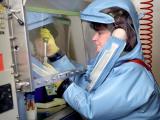Mar 11, 2003 (CIDRAP News) –The results of a spraying program to control gypsy moths in British Columbia suggest that terrorists could use conventional crop-dusting equipment to spread anthrax spores over a city and potentially infect people, according to a report in a new biodefense journal.
The spraying program, which involved Bacillus thuringiensis, a close relative of Bacillus anthracis (anthrax), produced particles small enough to penetrate into the lungs, according to the report in the debut issue of Biosecurity and Bioterrorism: Biodefense Strategy, Practice, and Science. The particles filtered into houses, the researchers found.
The study "provides data that refutes arguments asserting that there are technological barriers that would prevent all but major military programs from using B. anthracis as an aerosol disseminated bioweapon," states the report by David B. Levin, PhD, and Giovana Valadares de Amorim, MD, of the University of Victoria, B.C. "These data provide evidence that it is technologically feasible to disseminate biological agents from aircraft (or backpack sprayers, or truck-mounted foggers)."
The spraying was done in the Victoria, B.C., area in May and June of 1999 to eradicate gypsy moths, a threat to the local timber industry, according to the report. An off-the-shelf formulation of the biological insecticide Foray 48B, containing a 2.1% solution of B thuringiensis spores, was sprayed over an area of 30,157 acres housing a population of about 75,000 people. B thuringiensis is rarely infectious to humans, but the local public health authority studied the short-term human health effects of the spraying to allay public concern.
Researchers took air samples during the spraying at outdoor sites in and downwind of the spray zone to monitor the concentration of B thuringiensis spores. They also used special samplers inside and outside houses in the area to monitor the size distribution of the insecticide droplets. Three methods, including polymerase chain reaction and DNA dot-blot hybridization, were used to identify more than11,000 isolates of bacteria collected.
Bacillus species with genetic patterns consistent with the insecticide strain of B thuringiensis (Btk HD1) were found in 85% of isolates from the air samples, the report says. The average outdoor concentration of Btk HD1 during the 30-minute spraying period was 739 colony-forming units (CFU) per cubic meter of air, or about 739 spores per cubic meter.
The indoor concentration of Btk HD1 during and immediately after the spraying was only a fraction of the outdoor concentration, but it rose within hours, the researchers found. About 5 to 6 hours after spraying began, indoor concentration reached an average of 245 CFU/m3 of air, while the outdoor air concentrations were falling to an average of 77 CFU/m3.
The sprayers used in the program produced initial droplet sizes of 110 to 130 microns. But data from the air samplers showed that Btk HD1 particles ranging from 4.3 to 7.3 microns in diameter were present in both outdoor and indoor air after the spraying, the report says. Particles of 5 microns or smaller are considered small enough to lodge in the lungs.
It is not clear how the tiny particles were generated, the authors state. They speculate that the spray droplets may have been broken up by air pressure on release from the airplane, flying 230 mph, or they may have shrunk because of water evaporation.
The study didn't provide enough data to estimate how many spores people living in the spraying area inhaled. However, given the average respiration rate of an adult at rest, people could have been inhaling about 203spores per hour as of 5 to 6 hours after the spraying, the report says. In addition, nasal swab sampling of some asthmatic children in the zone yielded "a substantial number" of positive samples.
The report doesn't discuss whether an airborne attack with anthrax would produce a high enough concentration of spores to cause lethal inahalational anthrax cases in the affected area. Estimates of the lethal dose of inhaled anthrax vary all the way from a few spores to 55,000 spores. Studies of monkeys suggest that as few as 50 spores could be a lethal dose for 10% of people.
The article says some analysts have argued that crop dusters and foggers would not be effective ways to spread B anthracis because, unless the formulation were very pure, nozzles would clog and create globs that would fall harmlessly to the ground. Others have argued that aerial spraying of anthrax would be ineffective because most city people are inside most of the time and would therefore have some protection from contaminated air. The authors say their findings weigh against both of those arguments.
The spraying equipment used in the program was no more sophisticated than what aerial crop dusters generally use, author Levin, an associate professor of biology at the University of Victoria, told CIDRAP News. He said he would like to investigate whether backpack sprayers and truck-mounted foggers would have the same effects as aerial spraying, among other questions, but he has been unable to secure funds so far.
Levin DB, de Amorim GV. Potential for dissemination of biological weapons: lessons from biological control of insects. Biosecurity Bioterrorism 2003;1(1):37-42 [First page]


















